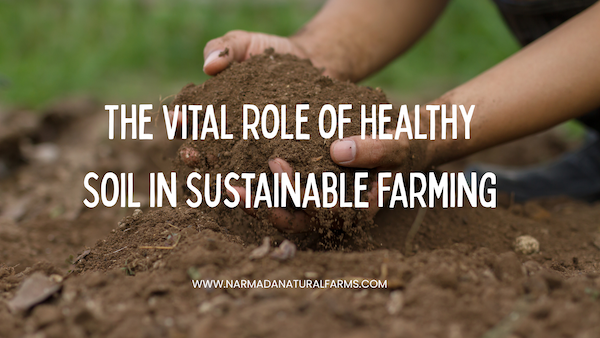Soil is more than just dirt beneath our feet; it is a living, breathing ecosystem that supports life on Earth. Healthy soil allows plants to grow to their maximum potential without the need for external chemical inputs. It is the foundation of productive agriculture and a sustainable environment. A deeper understanding of what makes soil healthy can help farmers improve crop yields while preserving the planet’s resources.
What is Healthy Soil?
Healthy soil supports robust plant growth while resisting pests and diseases. It does so naturally, without relying on synthetic fertilizers or pesticides. It is teeming with life—bacteria, fungi, algae, protozoa, nematodes, and other microorganisms. These tiny organisms play a critical role in maintaining soil health and ensuring the well-being of plants.
Also Read: Also Read: Understanding Natural Farming
Bacteria in soil produce natural antibiotics, protecting plants from diseases. Fungi help plants absorb water and nutrients from the soil. Together, bacteria and fungi form what is known as organic matter. The greater the organic matter in soil, the healthier it becomes. This rich ecosystem is what makes soil fertile and resilient.
How Do We Measure Healthy Soil?
Farmers and scientists assess soil health through several measurable factors. The presence of microorganisms is a key indicator. Soil teeming with bacteria and fungi is more likely to support thriving plants.
Nutrient content is another crucial factor. For example, nitrogen, an essential plant nutrient, must be present in adequate amounts. Water retention is equally important, particularly in areas prone to drought. Soil that retains moisture well can sustain plants during dry periods.
Carbon sequestration is also a valuable measure. Healthy soil can absorb carbon from the atmosphere, helping to combat climate change. Together, these factors provide a clear picture of soil health and its ability to support sustainable agriculture.
Why Does Healthy Soil Matter?
The benefits of healthy soil extend far beyond agriculture. Soil with a high level of organic matter contains aggregates that bind it together. This structure reduces erosion and runoff, ensuring that valuable topsoil remains intact.
Also Read: How To Increase Organic Carbon At Your Farm?
Healthy soil also holds more water. This makes it a vital resource during periods of drought, as plants growing in healthy soil are more resilient to water scarcity. Additionally, healthy soil harbors microorganisms that help plants fight diseases and pests naturally.
Nutrient-rich soil feeds plants effectively, leading to better yields and higher-quality crops. This creates a strong foundation for global food security. Healthy soil is not just an agricultural resource—it is a lifeline for the environment and humanity.
The Alarming Reality of Soil Degradation
Despite its importance, soil health is at significant risk. The United Nations has warned that, under current agricultural practices, the world has fewer than 60 years of farmable topsoil remaining. This shocking statistic highlights the urgent need for sustainable farming practices that prioritize soil conservation.
Degraded soil loses its structure, nutrients, and ability to retain water. It becomes vulnerable to erosion, leading to lower agricultural productivity. As the soil degrades, farmers are forced to rely on synthetic fertilizers and chemicals, creating a vicious cycle that further harms the ecosystem.
Also Read: The What, Why, and How of Soil Health at Your Farm
The Role of Natural Farming in Soil Conservation
Natural farming practices play a vital role in preserving and restoring soil health. These methods focus on enhancing the natural biological processes within the soil. By avoiding synthetic fertilizers and pesticides, natural farming allows microorganisms to thrive.
In natural farming, techniques such as crop rotation, cover cropping, and mulching improve soil structure and increase organic matter. These practices prevent erosion and enhance the soil’s ability to hold water. Moreover, natural farming encourages the growth of beneficial bacteria and fungi, boosting plant immunity and reducing pest attacks.
By adopting these methods, farmers can create a resilient agricultural system. Natural farming not only conserves soil but also contributes to a healthier environment. It reduces carbon emissions, enhances biodiversity, and supports sustainable food production.
A Call to Action
Healthy soil is the backbone of sustainable farming and global food security. Yet, it is under threat. Reversing soil degradation requires a collective effort from farmers, policymakers, and consumers.
Also Read: Earthworms in Natural Farming
Farmers can adopt natural farming techniques to rebuild soil health. Policymakers can incentivize sustainable practices through subsidies and education programs. Consumers can support this movement by choosing produce grown through natural farming methods.
Protecting soil health is not just an agricultural challenge—it is a necessity for the survival of future generations. By nurturing the soil, we nurture the planet. Together, we can ensure that the soil beneath our feet remains fertile, resilient, and capable of sustaining life for years to come.
Conclusion
Healthy soil is the cornerstone of a thriving ecosystem. It supports plant growth, combats climate change, and sustains the global food system. Yet, it is at risk. By embracing natural farming practices, we can protect this vital resource and secure a sustainable future for agriculture and the environment. The time to act is now.
***
Please send a WhatsApp message to 9303539939 or an email to narmadanaturalfarms@gmail.com for more details on consultancy, webinars, or to purchase produce/seeds. Follow on Instagram and X.
